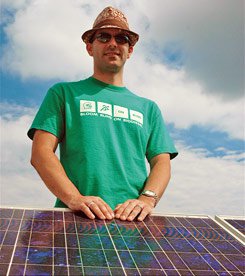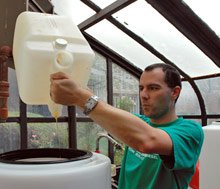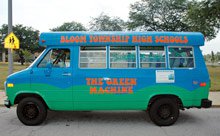School Retrofits Go Green
Old schools undergo green makeovers aimed at student health and financial savings.
Your content has been saved!
Go to My Saved Content.
Hollywood moviemakers in search of a Typical American High School might consider a scouting trip to Chicago Heights, Illinois. There, about 24 miles south of downtown, sits 75-year-old Bloom High School, a majestic slice of Art Deco elegance.
A white flagpole out front brandishes a wind-snapped flag, and just inside the heavy metal-and-glass entrance doors are six Depression-era frescoes portraying industrious Americans gainfully employed for the national good: building airplanes, working in engineering and industry, peering into microscopes.
Much like their iconic counterparts, today's Bloom students and teachers are deeply engaged in an ambitious campaign, this one aimed at the good of the planet. Projects designed to retrofit the historically significant high school for environmental sustainability can be found in every nook and cranny at Bloom -- from the rooftop to the basement to the leafy courtyards.
A solar-panel system generates enough electricity to power 24 classrooms, a courtyard greenhouse shelters vegetables and native prairie Illinois grass, a small "living wall" of plants filters air and water in a freshman biology classroom, and a handcrafted biodiesel production facility provides a living lab for chemistry students and fuel for one of Bloom's minibuses.
Together with smaller environmental initiatives at the school, like widespread installation of energy-efficient compact fluorescent "twisty bulbs" and automatic light sensors, the various components of the Bloom effort have begun to save the school thousands of dollars in energy costs while simultaneously helping many of the school's 1,700 students understand the science behind the climate crisis.
Fortunately for the rest of us, the fortuitously named Bloom High School isn't the only school to revamp an aging, urban institution to reflect an eco-ethic. Even as new, purpose-built green schools tend to grab the nation's attention, retrofitted traditional schools like Bloom are quietly taking steps to shrink their carbon footprints without a lot of fanfare.
Start Small
A green school is "one that is designed and operated to be environmentally sustainable and to provide a healthier indoor environment for students, teachers, and others," says Emily Dahl, a spokesperson for the Massachusetts Renewable Energy Trust. The buildings recycle as much as possible and use efficient lighting, renewable energy (typically gleaned from solar photovoltaic arrays), reusable and low-flow water systems, and nontoxic cleaning products. Natural lighting and improved acoustics play a key role. Often, these attributes can be added to existing schools, with the cost varying not just from project to project but also in relation to the age and health of the buildings.
Depending on the size and scope of the eco-friendly retrofit, individual project costs can run anywhere from a few hundred dollars -- say, for a year's supply of citrus-based cleaners and a pair of oversized recycling bins -- to $1,000 for two dozen new trees in a courtyard or a composting setup. For $150,000, a school can pay for a rooftop solar photovoltaic system and its installation. Typically, a phased approach is the only practical way to pull off an extreme green makeover on a public school budget.
Rachel Gutter, director for the education sector of the U.S. Green Building Council (USGBC), suggests that school administrators and educators start small and proceed incrementally. "We must get past the all-or-nothing preconception that a green school means a new or expensive school," she says. "Often, it's more cost effective not to do a tear-down of an old building but instead perform energy-efficient retrofits and renovations."
Richard Berliner, a Culver City, California, architect who has consulted extensively on school retrofits, agrees. "Have someone -- a sustainability consultant or an architect, for instance -- do a comprehensive analysis up front of all aspects of going green to identify the ones that are most viable in terms of implementation, up-front costs, ongoing maintenance costs, and impact to the school's daily function," he says.
More and more of the nation's 98,000-plus public schools are focusing on making retrofits green, meaning faster payback and improved health and well-being for occupants. A June 2007 energy audit at New Orleans's A.P. Tureaud Technology Academy, for instance, revealed that about 75 percent of the classroom lights at the school for grades preK-6 remained on throughout the evening hours when the 70-year-old building was unoccupied. Motion-based occupancy sensors were installed, cutting annual lighting needs by more than 25 percent and saving the school about $9,000 annually.
Other improvements at Tureaud included the installation of solar window screens on the east side of the building and weather stripping and caulking around doors to reduce heating and cooling costs. The improvements cost $68,612 and are expected to save the school $26,588 per year. This means the green investment will be recouped in about 2.5 years, according to Linda Morgano, Green Schools program associate at Global Green USA, which assisted in the retrofit.
On a larger scale, the Fresno Unified School District -- the fourth-largest school district in California, with more than 73,000 students -- recently completed a large retrofit project in 984 portable classrooms at 84 school sites, designed to save the district over $365,000 in annual electricity costs. School officials used some $316,000 in funding from the School Energy Efficiency Program, available to qualifying K-12 districts in 18 counties in California and administered by the Resource Solutions Group, to retrofit about 12,000 fixtures between March and July 2007. Outdated T-12 fluorescent fixtures were replaced with energy-efficient T-8 linear fluorescent lamps, reducing the electrical load in classrooms by 61 percent.
Funding for Going Green
Bloom High School chemistry and physics instructor Barry Latham and his colleague, biology instructor Jill Krysinski, initiated the midscale retrofit at Bloom in August 2008. They were fueled, in part, by $175,000 in grants from the Earth Day Network, in Washington, DC, in partnership with the Walmart Foundation. The teachers couldn't have done it without outside help.
"There are many, many challenges to going green at an older school," says Latham, not the least of which is raising enough cash to launch the projects. "If you walk into the principal's office and tell her you'd love to bring in a wonderful program that shows students how to make their own biodiesel, she'll say, 'Great, but we don't have the money to do that,'" he explains. "But if you walk in with a grant for $10,000 to develop a program for creating biodiesel in your classroom, the principal will say, 'How soon can you start?'"
Adds the Earth Day Network's Sean Miller, "Green efforts are typically not part of the line-item educational budget in any district or state. So, if you don't know how to write grants, you need to learn quickly."
Fortunately, many organizations provide grant monies focused on so-called green curricula. (See the Edutopia.org article "Five Funding Sources for Green Retrofits.") Funding sources can also spring up in unlikely places. Consider the case of Blackstone Valley Regional Vocational Technical High School, in Upton, Massachusetts.
The school was built in 1966 and serves 1,130 students. When school administrators began a green retrofit of the 220,000-square-foot, three-story building in 2003, they quickly realized they would need to update much of its aging electrical and ventilation system. Cost projections began to soar. (The total cost for the project was ultimately more than $35 million.)
School officials began digging for more funding sources and learned about the Massachusetts Department of Environmental Protection's Enforcement office. Senior administrators at the school noticed that the DEP had levied penalties on private-sector companies in the area. One construction company, for instance, owed a fine for a wetlands infraction; a power company had an operating-permit condition to mitigate regarding its carbon dioxide (CO2) emissions.
Under state law, companies that owe fines for environmental infractions can either pay the full penalty to the state or invest some portion of it in a Supplemental Environmental Project, which can be in their local community. Blackstone Valley received about $100,000 from the company that was being penalized for CO2 emissions and $40,000 from the wetlands fine. These funds were used for environmental improvements at the school.
Though the majority of funds for the Blackstone Valley retrofit came from a variety of public sources including municipal bonds, the school also received grants for the bulk of the green elements from the Massachusetts Renewable Energy Trust of more than $100,000. These were used to assess a variety of renewable energy sources -- including solar photovoltaic panels that generate electricity and solar hot water systems used to heat water.
Ultimately, the solar arrays and solar thermal system were acquired to generate electricity and hot water at Blackstone Valley. Together, along with other renewable-energy initiatives, they reduce overall energy costs at the school by more than 40 percent, or about $160,460, compared with a building that simply complies with existing codes.
Another potential source of funds is the federal government. In May, the U.S. House of Representatives passed the 21st Century Green High-Performing Public School Facilities Act (HR 2187), which would authorize $6.4 billion in fiscal year 2010 for public schools to modernize, renovate, and repair their buildings. The bill is now in committee in the U.S. Senate.

Big Rewards
The benefits of any environmental retrofit, no matter the size, nearly always include financial savings, even though some are not realized immediately. More efficient insulation and lighting may save a school tens of thousands of dollars, depending on the size of the school, the building's prior condition, and the extent of the changes. Designing schools green from the ground up could save as much as $100,000 a year, and about half of that in energy costs alone, according to USGBC estimates. Recycling -- with its reduced waste-disposal costs -- and water-conservation programs can save thousands of dollars more.
Less easy to calculate are the nonfiduciary benefits of green retrofits. More efficient lighting and heating can dramatically improve the learning environment and improve student health. Green projects can also serve as vibrant teaching tools, becoming part of high-level lesson plans in science and math, or in integrated studies, adding design, social science, or urban planning to the mix.

At Bloom, a key element of the retrofit is to foster student learning throughout the process of modifying school buildings and operations. For instance, teacher Barry Latham supervised 120 students in assembling and installing the three dozen solar panels designed to provide electricity for the school. "Every bolt, every shingle, every brick was done by the kids," he says.
The solar setup, the most expensive project in the retrofit, has saved the school thousands of dollars in electricity costs since its installation in October 2008, Latham says. It has also prevented more than 73 tons of carbon dioxide, 54 pounds of nitrogen oxide, 136 pounds of sulfur dioxide, and 700 milligrams of mercury from being released into the air. The decrease of so much CO2 alone is the equivalent of planting almost 7 acres of trees per year.
The rest of the Bloom plan is comparatively low budget, but the education yield is high. Students and educators work at planting trees and recycling plastics, two projects that can be executed for less than $500 each. Though they don't save the school any money in heating or lighting, "they get kids thinking about how they can, through small projects and day-to-day activities, begin to live a more environmentally conscious life," teacher Jill Krysinski says.
Another low-cost linchpin in the Bloom eco-plan is the school's impressively named biodiesel reactor. The "reactor" is really just a series of tanks and separators that looks very homegrown. It's mostly store-bought material: no welding, a little bit of electrical tape, simple piping. The reactor, pumps, and chemicals cost about $2,500. In the past year, using leftover cooking oil from the cafeteria, students in Latham's science classes have produced more than 1,000 gallons of biodiesel, enough to power a school minibus and some of the school's tractors.

Krysinski uses the bus for an educational outreach program. Ms. K, as the students affectionately label her, supervises what she calls "the fun stuff" at Bloom. She believes if the kids are excited, the parents and the community are excited. And when the community is excited, she explains, you scale a very important wall when seeking funding on critical things like municipal bonds.
Chicago Heights turns out to be "a perfect locale for teaching kids about the green economy and why it matters," says Krysinski. The city has a long love affair with industry, but unfortunately, the factories brought clanking and pollution. Today, much of that industry has pulled up and gone, but on every block, near every street corner, there are weedy, empty lots where gas stations, a paint company, or a factory once stood. "The importance of a green school is very real to our students," Krysinski says.
Ultimately, say educators and ecologists, it is this connection with real life that helps drive the need for ecological retrofits. "This is about more than the building," says the USGBC's Rachel Gutter. "Ultimately, we want to create green natives, who, in their lifetime won't have to label something as a green building. Because, one day, that's how all buildings will be constructed."